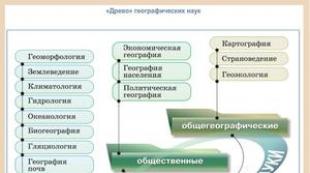What happens to the substance during assimilation. Assimilation and dissimilation as the basis for self-renewal of biological systems. Definition, essence, meaning. Oxygen stage of energy metabolism
Under the action of biological catalysts (enzymes), new substances are formed from compounds (food components) entering the body, from which its cells are built. This is how the process is carried out assimilation(anabolism) - assimilation of substances necessary for the body and their transformation into compounds analogous to the components of this organism and necessary for its vital activity.
Simultaneously with the process of assimilation in the body, the process also occurs dissimilation(catabolism), in which complex organic compounds formed and accumulated during assimilation are also enzymatically decomposed to simpler compounds or end products with a gradual release of energy, most often in the form of ATP, which is used for various vital processes, including the synthesis of new compounds.
Assimilation and dissimilation, although processes opposite in results, are fundamentally closely interrelated and interdependent. Their interrelation is found in the expenditure on the biosynthesis of substances (assimilation) of the energy that is released in the process of dissimilation. Without this energy, the breakdown products of proteins, fats and carbohydrates, which are necessary for biosynthesis, cannot be formed. On the other hand, assimilation determines the accumulation of the corresponding energetic material in the body. These processes are the most important links metabolism- a set of processes of biochemical transformations of substances and energy in living organisms, metabolism.
Assimilation is also called the exchange of plastic, nutrients, and dissimilation is called energy metabolism. For assimilation in green plants, the energy of absorbed light rays is used, in chemosynthetic microorganisms - the energy released during their oxidation of various inorganic substances.
ATP is a universal source of energy in the cell. In the human body, animals, most microorganisms, the necessary energy is generated in catabolic reactions during respiration or fermentation. This energy, before transforming into any other form (mechanical, osmotic), is converted into a special form of chemical energy - the energy of the high-energy bonds of the molecules of adenosine triphosphoric acid. In most organisms, the energy released during one enzymatic reaction is a link in the "catalytic conveyor" - a cascade of energy release. The accumulation and transport of energy are carried out with the help of one and universal source of energy for the functional activity of the cell - ATP.
The main substances from which the cell obtains energy in ATP are widespread monosaccharides, primarily glucose. Among the many methods of glucose breakdown, an important role is played by two closely related processes based on the anaerobic breakdown of the substrate - glycolysis and different types of fermentation of glycolysis products.
All biosynthetic reactions take place with the absorption of energy.
The set of reactions of biosynthesis is called plastic exchange or assimilation (Latin "similis" - similar). The meaning of this process is that food substances entering the cell from the external environment, which are sharply different from the substance of the cell, become cell substances as a result of chemical transformations.
Cleavage reactions. Complex substances break down into simpler ones, high-molecular substances - into low-molecular ones. Proteins break down into amino acids, starch into glucose. These substances are split into even lower molecular weight compounds, and in the end, very simple, energy-poor substances - CO2 and H2O - are formed. Cleavage reactions in most cases are accompanied by the release of energy. Biological significance these reactions is to provide the cell with energy. Any form of activity - movement, secretion, biosynthesis, etc. - requires the expenditure of energy.
The aggregate of the cleavage reaction is called energy metabolism of the cell or dissimilation. Dissimilation is directly opposite to assimilation: as a result of cleavage, substances lose their resemblance to cell substances.
Plastic and energy exchanges (assimilation and dissimilation) are inextricably linked with each other. On the one hand, biosynthetic reactions require the expenditure of energy, which is drawn from the cleavage reactions. On the other hand, for the implementation of reactions of energy metabolism, constant biosynthesis of enzymes serving these reactions is necessary, since in the process of work they wear out and are destroyed.
The complex systems of reactions that make up the process of plastic and energy exchanges are closely related not only to each other, but also to the external environment. Nutrient substances enter the cell from the external environment, which serve as material for the reactions of plastic metabolism, and in the reactions of cleavage, the energy necessary for the functioning of the cell is released from them. Substances are released into the external environment that can no longer be used by the cell.
The totality of all enzymatic reactions of the cell, that is, the totality of plastic and energy exchanges (assimilation and dissimilation) associated with each other and with the external environment, is called the exchange of substances and energy. This process is the main condition for maintaining the life of the cell, the source of its growth, development and functioning ...
19. Metabolism and energy in the cell. Photosynthesis, chemosynthesis. Assimilation process (main reactions). Metabolism is a unity of assimilation and dissimilation. Dissimilation is an exothermic process, i.e. the process of releasing energy due to the disintegration of cell substances. Substances formed during dissimilation also undergo further transformations. Assimilation is the process of assimilating substances entering a cell with specific substances characteristic of a given cell. Assimilation is an endothermic process that requires energy consumption. The source of energy is previously synthesized substances that have undergone decay in the process of dissimilation. Photosynthesis is the process of converting the energy of sunlight into the energy of chemical compounds. Photosynthesis is the process of the formation of organic substances (glucose, and then starch) from inorganic substances, in chloroplasts in the light with the release of oxygen. Photosynthesis takes place in 2 phases: light and shadow. The light phase occurs in the light. During the light phase, chlorophyll is excited by absorbing a quantum of light. In the light phase, photolysis of water occurs, followed by the release of oxygen into the atmosphere. In addition, the following processes take place in the light phase of photosynthesis: the accumulation of hydrogen protons, the synthesis of ATP from ADP, the addition of H + to a special carrier NADP
RESULT OF LIGHT REACTION:
Formation of ATP and NADP * H, release of O2 into the atmosphere.
Dark phase(CO2 fixation cycle, Calvin cycle) takes place in the chloroplast stroma. In the dark phase, the following processes occur
ATP and NADP * H are taken from the light reaction
From the atmosphere - CO2
1) CO2 fixation
2) Formation of glucose
3) Starch formation
FINAL EQUATION:
6CO2 + 6H2O— (chlorophyll, light) -C6H12O6 + 6O2
Chemosynthesis is the synthesis of organic substances due to the energy of chemical reactions. Chemosynthesis is carried out by bacteria Main reactions of photosynthesis: 1) oxidation of sulfur: 2H2S + O2 = 2H20 + 2S
2S + O2 + 2H2O = 2H2SO4 2) nitrogen oxidation: 2NH3 + 3O2 = 2HNO2 + 2H2O 2HNO2 + O2 = HNO3 3) oxygen oxidation 2H2 + O2 = 2H2O 4) iron oxidation: 4FeCO3 + O2 + 6H2O = 4Fe (OH) 3 + 4CO2
20. Metabolism in the cell. Dissimilation process. The main stages of energy metabolism. Metabolism is a unity of assimilation and dissimilation. during dissimilation, they also undergo further transformations. Assimilation is the process of assimilating substances entering a cell with specific substances characteristic of a given cell. Assimilation is an endothermic process that requires energy consumption. The source of energy is previously synthesized substances that have undergone decay in the process of dissimilation. Dissimilation is an exothermic process, i.e. the process of releasing energy due to the disintegration of cell substances. Substances formed All the functions performed by the cell require the expenditure of energy, which is released in the process of dissimilation. The biological significance of dissimilation is reduced not only to the release of energy required by the cell, but often to the destruction of substances harmful to the body. The entire process of dissimilation, or energy metabolism, consists of 3 stages: preparatory, oxygen-free and oxygen. In the preparatory stage, under the action of enzymes, the polymers are split into monomers. So, proteins are broken down to amino acids, polysaccharides - to monosaccharides, fats - to glycerol and fatty acids. In the preparatory stage, little energy is released and usually dissipated in the form of heat. 2) Anoxic or anaerobic stage. Let's look at glucose as an example. In the anaerobic stage, glucose decomposes to lactic acid: C6H12O6 + 2ADP + H3PO4 = 2C3H6O3 + 2H2O + 2ATP (lactic acid) 3) Oxygen stage. At the oxygen stage, substances are oxidized to CO2 and H2O. When oxygen is available, pyruvic acid penetrates into mitochondria and undergoes oxidation: С3H6O3 + 6O2-6CO2 + 6H2O + 36ATP Total equation: C6H12O6 + 6O2-6CO2 + 6H2O + 38ATP
Dissimilation is a complex of chemical reactions in which complex organic substances gradually decompose to simpler ones. This process is accompanied by the release of energy, a significant part of which is used in the synthesis of ATP.
Dissimilation in biology
Dissimilation is the opposite process of assimilation. Nucleic acids, proteins, fats, and carbohydrates are the starting materials to be degraded. And the end products are water, carbon dioxide and ammonia. In the body of animals, decay products are excreted as they gradually accumulate. And in plants, carbon dioxide is partially released, and ammonia is fully used in the assimilation process, serving as a starting material for biosynthesis. organic compounds.
The relationship between dissimilation and assimilation allows the tissues of the body to be constantly renewed. For example, within 10 days, half of the albumin cells are renewed in human blood, and all red blood cells are reborn in 4 months. The ratio of the intensity of two opposite metabolic processes depends on many factors. This is the stage of development of the organism, and age, and physiological state. In the course of growth and development, assimilation prevails in the body, as a result new cells, tissues and organs are formed, their differentiation occurs, that is, the body weight increases. In the case of pathologies and fasting, the process of dissimilation prevails over assimilation, and the body decreases in weight.
All organisms can be divided into two groups, depending on the conditions in which dissimilation takes place. These are aerobes and anaerobes. The former require free oxygen for life, the latter do not feel the need for it. In anaerobes, dissimilation proceeds by fermentation, which is an oxygen-free enzymatic breakdown of organic substances into simpler ones. For example, lactic acid or alcoholic fermentation.
The breakdown of organic matter in aerobes is carried out in three steps. At the same time, several specific enzymatic reactions take place on each of them.
The first stage is preparatory. The main role at this stage belongs to the digestive enzymes in the gastrointestinal tract in multicellular organisms. In unicellular organisms - lysosome enzymes. During the first stage, proteins break down into amino acids, fats form glycerol and fatty acids, polysaccharides are broken down into monosaccharides, nucleic acids into nucleotides.
Glycolysis
The second stage of dissimilation is glycolysis. It runs without oxygen. The biological essence of glycolysis is that it is the beginning of the breakdown and oxidation of glucose, resulting in the accumulation of free energy in the form of 2 ATP molecules. This occurs in the course of several consecutive reactions, the end result of which is the formation of two molecules of pyruvate from one glucose molecule and the same amount of ATP. It is in the form of adenosine triphosphoric acid that part of the energy released as a result of glycolysis is stored, the rest is subject to dissipation in the form of heat. Chemical reaction of glycolysis: C6H12O6 + 2ADP + 2F → 2C3H4O3 + 2ATP.
In conditions of a lack of oxygen in plant cells and in yeast cells, pyruvrate is split into two substances: ethyl alcohol and carbon dioxide. This is alcoholic fermentation.
The amount of energy released during glycolysis is not sufficient for those organisms that breathe oxygen. That is why lactic acid is synthesized in the body of animals and humans during high physical exertion in the muscles, which serves as a reserve source of energy and accumulates in the form of lactate. A characteristic feature of this process is the appearance of muscle pain.
Dissimilation is a very complex process, and the third oxygen stage is also two consecutive reactions. We are talking about the Krebs cycle and oxidative phosphorylation.
In the course of oxygen respiration, pyruvirate is oxidized to the final products, which are CO2 and H2O. In this case, energy is released, stored in the form of 36 ATP molecules. Then the same energy provides the synthesis of organic substances in the plastic volume. Evolutionarily, the emergence of this stage is associated with the accumulation of molecular oxygen in the atmosphere and the emergence of aerobic organisms.

The site of oxidative phosphorylation (cellular respiration) is the inner mitochondrial membranes, inside which there are carrier molecules that transport electrons to molecular oxygen. The energy generated at this stage is partially dissipated in the form of heat, while the rest goes to the formation of ATP.
Dissimilation in biology is an energy exchange, the reaction of which looks like this: C6H12O6 + 6O2 → 6CO2 + 6H2O + 38ATP.
Thus, dissimilation is a set of reactions occurring due to organic substances that were previously synthesized by the cell, and free oxygen, which came from the external environment during respiration.
Assimilation, anabolism(lat. Assimilo - I liken - assimilation, fusion, assimilation) - in biology - the processing and use by organisms of substances coming from the environment.
Assimilation and the opposite process inextricably linked with it - dissimilation - underlie the most important property of living matter - metabolism. The nature of these continuous processes determines the vitality and development of the organism.
Through assimilation, the body builds its body at the expense of the environment; growth of an organism is possible if assimilation prevails over dissimilation.
The essence assimilation is basically reduced to the synthesis of all substances necessary for the vital activity of the organism in a certain way, which has developed in the process of evolution. So, in autotrophic organisms, during assimilation, complex organic compounds are synthesized from inorganic ones, for example, during photosynthesis, carbohydrates are assimilated by green plants from carbon dioxide of air and water. In heterotrophic organisms that feed only on substances of plant and animal origin, synthesis during assimilation is preceded by their splitting and processing.
The characteristics of organisms acquired in the process of evolution determine the nature of assimilation, but changes in assimilation, in turn, affect the nature of organisms, changing their heredity.
When the quanta of light hit the chlorophyll, the chlorophyll molecules are excited. Excited electrons pass through the electron chain on the membrane to the synthesis of ATP. At the same time, the splitting of water molecules occurs. H + ions combine with reduced NADP (PS1) due to chlorophyll electrons; the resulting energy is used to synthesize ATP. O 2 ions donate electrons to chlorophyll (PS2) and turn into free oxygen: H 2 O + NADP + hν → NADPH + H + + 1 / 2O 2 + 2ATP
Dark phase Dark phase - fixation of C, synthesis of C 6 H 12 O 6. The source of energy is ATP. In the stroma of chromoplasts (where ATP, NADPH and H + come from the thylakoids of gran and CO 2 from the air), cyclic reactions take place, as a result of which there is fixation of CO 2, its reduction of H (due to NADPH + H +) and the synthesis of C 6 H 12 O 6:
CO 2 + NADPH + H + + 2ATP → 2ADP + C 6 H 12 O 6
Dissimilation in biology means the opposite process of assimilation. In other words, this is the stage of metabolism in the body, at which the destruction of complex organic compounds occurs to obtain simpler ones. There are several different definitions of the concept of dissimilation. Wikipedia interprets this term as the loss of the specificity of complex substances and the destruction of complex organic compounds to simpler ones. A synonym for this concept is catabolism.
In the metabolism in a living cell, the central place is occupied by complex dissimilation reactions - respiration, fermentation, glycolysis. The result of these biological processes is the release of energy, which is contained in complex molecules. This energy is partially transformed into the energy of Adenosine triphosphoric acid (ATP). The end products of dissimilation in all living cells are carbon dioxide, ammonia and water. Plant cells were able to partially use these substances for assimilation. Animals carry these decay products out..
According to the nature of the participation of oxygen molecules in catabolic reactions, all organisms are usually divided into aerobic, that is, flowing with the participation of oxygen, and anaerobic (anoxic).
Anaerobic organisms carry out energy metabolism processes by fermentation, and aerobic organisms - by breathing.
Fermentation is a set of reactions of decomposition of organic molecules to simpler compounds, in which energy is released and ATP molecules are synthesized. Among other methods of obtaining energy, fermentation is considered the most ineffective: from 1 mol of glucose during lactic acid fermentation, 2 mol of ATP is obtained.
The most widespread in nature are two types of fermentation:
- Lactic acid - includes the process of anaerobic breakdown of glucose with the formation of lactic acid. This type of fermentation is characteristic of lactic acid bacteria - they are responsible for sour milk. In a broader sense, the process of lactic acid fermentation is one of the stages of the respiration process in the vast majority of aerobic organisms, including humans;
- Alcoholic fermentation is a process of anaerobic breakdown of glucose and is accompanied by the formation of carbon dioxide and ethyl alcohol. In the course of this reaction, a certain amount of energy is released, which is spent on the synthesis of the ATP molecule. Alcoholic fermentation is most typical for fruits and other parts of the plant under anaerobic conditions.
Breathing in the context of the disclosed question has a broader meaning than the usual process of gas exchange. In this case, respiration should be understood as a kind of dissimilation that occurs in an environment containing oxygen molecules.
The breathing process has two parts:
- The process of gas exchange in the respiratory system of multicellular organisms and in tissues;
- The sequence of biochemical oxidation reactions that organic compounds undergo. As a result of these processes, water, ammonia and carbon dioxide are formed. The formation of some other simple compounds is possible - hydrogen sulfide, inorganic phosphorus compounds, etc.
For most people, a narrower interpretation of the breathing process as gas exchange is customary.
The process of dissimilation in living cells consists of several stages. It should be noted that these stages can proceed in different ways in different organisms.
In aerobic organisms, the process of catabolism includes three main stages. Each stage takes place with the participation of special enzymatic systems.
- Initial stage or preparatory. In multicellular organisms, it is carried out in the cavity of the digestive tract. Digestive enzymes are directly involved in the process. In unicellular organisms, this stage proceeds with the participation of lysosomal enzymes. At the preparatory stage, proteins are broken down into amino acids. Fats break down to fatty acids and glycerin. Polysaccharides are cleaved at this stage to monosaccharides, and nucleic acids to nucleotides. In biology, such a process is usually called digestive;
- The second stage of catabolism is glycolysis or anoxic. This stage is the initial stage of the breakdown of glucose molecules and the accumulation of energy in the form of Adenosine triphosphoric acid molecules. Glycolysis takes place in the cell cytoplasm. At this time, a sequence of chemical reactions is observed: one glucose molecule is converted into two molecules of pyruvic acid (or pyruvate) and two ATP molecules. Part of the released energy is stored in the form of ATP, the rest is dissipated in the form of heat. Under conditions of a lack of oxygen in the cells of plants and yeasts, pyruvate molecules are split into carbon dioxide and ethanol (alcoholic fermentation);
- The oxygen stage of catabolism consists, in turn, of two successive phases - the Krebs cycle and oxidative phosphorylation. Let us consider what stage of dissimilation is called oxygen. Here, the final cleavage of pyruvate to the simplest constituents - water and carbon dioxide takes place. During the oxidation of pyruvate, only 36 ATP molecules are formed. Of these, 34 molecules are formed as a result of a chain of reactions of the Krebs cycle and the remaining 2 - as a result of oxidative phosphorylation. Evolutionarily, the oxygen stage arose after a sufficient number of oxygen molecules had accumulated in the earth's atmosphere and organisms with an aerobic type of metabolism appeared.
As a result of dissimilation reactions energy is obtained, which is subsequently used by the body for plastic metabolism.
Oxidative phosphorylation processes occur on the inner mitochondrial membranes. These membranes have embedded carrier molecules. Their function is to deliver electrons to oxygen atoms. Some of the energy in this reaction is dissipated as heat.
As a result of glycolysis reactions, a small amount of energy is produced, which is not enough for the vital activity of organisms with an aerobic type of metabolism. This is the reason why, when there is a lack of oxygen, lactic acid is formed in muscle cells. This substance accumulates as lactate and causes muscle pain.
DISSIMILATION AND ASSIMILATION
DISSIMILATION AND ASSIMILATION
(from Lat. dissimilis - dissimilar and assimilis - similar) - mutually opposite processes, providing in the unity of the continuous vital activity of living organisms; proceed in the body continuously, simultaneously, in close interconnection and constitute two sides of a single metabolic process. D. and A. form a complex system consisting of a chain of interconnected biochemicals. reactions, each of to-ryh separately is only chemical, but to-rye in unity are, possessing biological. nature. Contradiction between D. and A. defines dynamic. balance of a living body. As open (see Life), it must, constantly acquiring, just as continuously spend the acquired energy, so that it does not increase.
D and s and m and lats and I - the process of splitting in a living organism organic. substances into simpler compounds - leads to the release of energy necessary for all vital processes of the body. And with s and m and lats and I - the process of assimilation of organic. substances entering, and comparing them organic. substances inherent in this organism, it goes with the use of energy released during the processes of dissimilation. In this case, compounds with high energy (high-energy) are formed (synthesized), to-rye become a source of energy released during dissimilation.
Dissimilation of nutrients entering the body, mainly proteins, fats and carbohydrates, begins with their enzymatic breakdown into simpler compounds - intermediate metabolic products (peptides, amino acids, glycerin, fatty acids, monosaccharides), from which the body synthesizes (assimilates ) organic connections necessary for his life. All D. and A. processes. in the body proceed as a whole. See Metabolism, Life and lit. with these articles.
I. Vaysfeld. Moscow.
Philosophical Encyclopedia. In 5 volumes - M .: Soviet encyclopedia. Edited by F.V. Konstantinov. 1960-1970 .
See what "DISSIMILATION AND ASSIMILATION" is in other dictionaries:
- (lat.assimilatio, from assimilare to liken). Equation, assimilation, for example, in phonetics, assimilation of neighboring sounds to one another; in physiology, the assimilation of substances absorbed by animals, substances of their own body. Dictionary of foreign words, ... ...
- [lat. dissimilatio distribution] ling. a change that destroys the similarity and similarity of sounds in a word. Dictionary of foreign words. Komlev N.G., 2006. dissimilation (lat. Dissimilatio dissimilation) 1) otherwise catabolism decomposition of complex organic ... ... Dictionary of foreign words of the Russian language
Assimilation- (from Lat. assimilatio reproduction), anabolism, a process during which more complex substances are synthesized from simpler substances (polysaccharides, nucleic acids, proteins, etc.), similar to the components of this organism and necessary for it ... ... Ecological Dictionary
The term assimilation (lat. Assimilatio assimilation) is used in several areas of knowledge: Assimilation (biology) is a set of synthesis processes in a living organism. Assimilation (linguistics) assimilation of the articulation of one ... Wikipedia
- (lat. dissimilatio distribution). Replacing one of two identical or similar sounds with another, less similar in articulation to the one that remained unchanged. Like assimilation, dissimilation can be progressive and regressive. ... ...
I w. A change that violates the similarity, the similarity of the same or similar sounds in a word or in neighboring words; distribution (in linguistics). Ant: assimilation I II f. Breakdown in the body of complex organic substances, cells, tissues, etc. (in biology) ... Modern explanatory dictionary Russian language Efremova
- (lat. assimilatio assimilation). Assimilation of one sound to another in articulatory and acoustic terms (cf .: dissimilation). Assimilation occurs in vowels with vowels, in consonants with consonants ... Dictionary of linguistic terms
I Assimilation (from Lat. Assimilatio) assimilation, fusion, assimilation. II Assimilation (ethnographic) fusion of one people with another with the loss of one of them of their language, culture, national identity. In many countries in ... ...
I Dissimilation (from Latin dissimilis dissimilar) in biology, opposite to assimilation (See Assimilation) side of metabolism (See Metabolism), which consists in the destruction of organic compounds with the transformation of proteins, nucleic acids ... ... Great Soviet Encyclopedia
Assimilation- this is the totality of all complex creative processes taking place in cells, and therefore in an integral organism. During assimilation, energy is accumulated.
Dissimilation is a set of oxidative processes in which energy is released. It is this energy that is used in the future for the implementation of all vital functions of the body.
Thus, these two opposite processes are so interconnected with each other that the cessation of one of them entails the cessation of all metabolism, and, consequently, of life.
Despite such a strong relationship and interdependence, the processes of assimilation and dissimilation are not always mutually balanced. Age is of prime importance here.
The younger the human body, the more intensively the assimilation processes take place in it. In elderly people, on the contrary, dissimilation prevails over assimilation. A particularly intense metabolism is observed in newborns and adolescents during puberty.
Chemical transformations of substances in the body are part of a complex process called metabolism. Man gets nutrients, water, mineral salts and vitamins from the environment. It emits carbon dioxide, a certain amount of moisture, mineral salts, organic substances into the environment.
In the process of metabolism, a person receives energy accumulated in products of animal and plant origin, and gives off thermal energy to the surrounding space. This is how the metabolism and energy are constantly being exchanged. environment through which a person is included in the general circulation of substances in nature. The exchange of substances between the body and the environment - necessary condition the existence of living organisms.
Assimilation, accumulation of substances and energy is called assimilation. In the course of assimilation of nutrients and other substances, proteins, fats, glycogen are formed, new cells are built. Substances formed in the process of assimilation undergo complex chemical changes and energy is released. This process is called dissimilation. Chemical reactions that release energy take place in the mitochondria of cells.
The processes of assimilation and dissimilation not only proceed simultaneously. The energy required for digesting food, transporting nutrients and storing them (assimilation) is generated by dissimilation. This means that assimilation depends on dissimilation and is closely related to it. Assimilation and dissimilation is a single process that constantly takes place in cells and throughout the body, the process of metabolism and energy.
The exchange of substances with the environment is not only a condition for the existence of organisms, but also their main, distinctive property. F. Engels wrote:
"Life is a way of existence of protein bodies, an essential point of which is a constant exchange of substances with the surrounding external nature, and with the cessation of this metabolism, life also stops, which leads to the decomposition of protein"
Metabolic processes are completely subject to the law of conservation of mass and energy. Studies specially designed for this purpose have shown that the amount of energy formed in the body is equal to the store of potential energy received with food. The weight of substances entering the body and released from it is the same. But weight gain or loss must be considered.
"Human Anatomy and Physiology", M.S. Milovzorova
Many chemical elements are part of the human body. The content of some chemical elements in the human body: Elements that are necessarily present in the body: Calcium Phosphorus Potassium Sulfur Chlorine Sodium Magnesium Iron Iodine Trace elements with negligible content in the body: Copper Manganese Zinc Fluorine Silicon Arsenic Aluminum Lead Lithium In the body, they are present mainly in the form of salts and some acids ....
Of the total metabolism, 40-50% is carried out in the skeletal muscles. Any muscle activity increases muscle metabolism. When sitting quietly compared to lying quietly, it increases by 12%. Standing increases metabolism by 20% and running by 400%. Moreover, a person who is well trained for this type of muscle work spends less energy on its implementation than a beginner. Explained ...
Different departments are involved in the regulation and implementation of metabolism. nervous system... Metabolism and energy, adapting it to the needs of the body, occur under the influence of the cerebral cortex. Thus, for trained athletes at the stadium and in the sports hall, gas exchange increases long before the start of the competition. An increase in exchange is also observed among fans, despite the fact that they are only visually participating ...
Formation and release of decay products Metabolism in the body ends with the formation of decay products. They are produced in cells as a result of tissue metabolism. These include carbon dioxide, water, organic matter(for example, lactic acid), minerals - salts, iron and other metals. The body is freed from them through the excretory organs. In addition to the end products, the body excretes substances formed during the destruction of dying ones ...
The release of decay products is the last stage in the metabolism of proteins, fats and carbohydrates, which is very important for the normal functioning and existence of the body. Final and other excreted products and some substances introduced with drugs, accumulating in tissues, can poison the body. Through the excretory organs, they are excreted from the body. The main function of the excretory organs is to maintain the relative constancy of the internal environment of the body, ...









